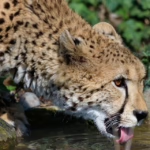The Art of Nature: How Mother Nature Inspires Creativity in Us All
Introduction
Nature has long been a wellspring of inspiration for artists, writers, musicians, and creatives across all disciplines. From the majestic mountains standing sentinel over the valleys to the minute details of a dew-kissed spider web, the natural world offers endless material for contemplation and creativity. This article explores the profound influence of nature on human creativity, delving into historical contexts, psychological insights, and contemporary examples of how the great outdoors inspires artistic expression.
The Historical Context of Nature in Art
Prehistoric Art and Nature
The earliest forms of human artistic expression, such as cave paintings found in Lascaux and Altamira, depict animals and natural landscapes. These works not only served a communicative function but also illustrated the deep connection early humans had with their environment. Animals were essential for survival, and their representation in art suggests an inherent reverence for nature. This initial symbiosis between human creativity and the natural world set the stage for centuries of artistic exploration.
Classical Antiquity
In classical antiquity, the Greeks and Romans celebrated nature through sculpture and poetry. The works of Homer and Virgil glorified pastoral life and nature’s beauty, suggesting that the divine was present in the natural world. The Roman poet Ovid, in his "Metamorphoses," weaves narratives that intertwine nature with themes of transformation and creativity, indicating that the natural world was viewed as a source of wisdom and inspiration.
The Renaissance: A New Appreciation for Nature
The Renaissance marked a significant shift in how artists perceived and represented nature. Artists like Leonardo da Vinci and Michelangelo studied natural forms to depict the human body more realistically. Their sketches of leaves, flowers, and landscapes reveal an analytical yet reverent relationship with the natural world. Nature was not merely a backdrop; it became essential to understanding humanity itself.
Psychological Insights
Nature and the Creative Process
Research indicates that exposure to nature can enhance cognitive abilities, including problem-solving and creative thinking. A landmark study by Ruth Ann Atchley and David Strayer, published in PLoS ONE, found that participants exhibited a 50% increase in creative problem-solving skills after spending several days in nature. This phenomenon is known as the "four-day effect." The authors argue that natural environments reduce cognitive overload, allowing the mind to wander and explore new ideas freely.
Nature’s Healing Power
The psychological benefits of connecting with nature extend beyond creativity. Studies show that spending time outdoors can lower stress, improve mood, and even enhance focus. This mental clarity often translates into enhanced creativity. In his book "Last Child in the Woods," Richard Louv coins the term "nature-deficit disorder," suggesting that the lack of interaction with the natural world can stifle creativity and imagination, especially in children.
The Role of Nature in Various Artistic Mediums
Visual Arts
Nature has been a prominent subject in visual arts, from traditional painting to modern photography. The Impressionists, for example, captured the ephemeral qualities of light and atmosphere in their landscapes, transforming how nature was perceived in art. Claude Monet’s "Water Lilies" series exemplifies this approach, where the interplay of light on water becomes an exploration of perception rather than a mere representation of reality.
Contemporary artists continue to draw inspiration from nature. For instance, the work of Andy Goldsworthy, who creates site-specific installations from natural materials like leaves, stones, and ice, emphasizes the transient beauty of the natural world and evokes a sense of place.
Literature
Nature has also inspired countless writers. The American Transcendentalists, including Ralph Waldo Emerson and Henry David Thoreau, celebrated the beauty and spirituality of the natural world in their works. Thoreau’s "Walden" is both a reflection on simple living in natural surroundings and a profound meditation on mankind’s relationship with nature.
Modern literature continues to reflect this connection, with authors like Annie Dillard and Barry Lopez exploring nature’s complexities and its impact on the human experience. Dillard’s "Pilgrim at Tinker Creek" uses detailed observations of the natural world to reveal philosophical insights about existence and creativity.
Music
Musicians have found inspiration in the rhythms and sounds of nature. The Romantic composers, such as Beethoven and Liszt, often incorporated natural themes into their music. Beethoven’s "Pastoral Symphony" is a quintessential example, depicting a rural landscape and celebrating the peacefulness of nature.
In contemporary music, bands like Sigur Rós and Fleet Foxes draw on natural imagery and themes, evoking emotional landscapes that resonate with the listener’s experiences of the natural world. This connection between music and nature serves to elevate the listener’s experience, inviting them to reflect on their own relationship with the environment.
The Intersection of Nature, Creativity, and Technology
The Influence of Digital Technology
In today’s digital age, the relationship between nature and creativity is evolving. Virtual reality (VR) experiences immerse users in digital representations of natural environments, allowing for new forms of artistic expression and interaction with nature. Artists like Anna Akhmatova create virtual landscapes that transcend physical limitations, folding aspects of nature into digital realms.
However, the rise of technology poses challenges. The increasing disconnect from the natural world can lead to diminished creativity, as discussed by Richard Louv. It’s essential to strike a balance between embracing technological advancements and nurturing our connection to the natural environment, which fosters creativity.
Nature-inspired Art: Case Studies
The Hudson River School
The Hudson River School, a mid-19th-century American art movement, exemplified the deep appreciation for nature among its painters. Artists like Thomas Cole and Frederic Edwin Church depicted the American landscape’s grandeur, infusing their works with themes of exploration and national identity. Their paintings evoke a sense of awe and inspire viewers to appreciate the sublime beauty of the natural world.
Environmental Art
Contemporary environmental artists like Christo and Jeanne-Claude have made a powerful statement about human interaction with nature. Their large-scale installations, such as “The Gates” in Central Park, highlight the relationship between man and nature, raising awareness of environmental issues. These installations function as both art and advocacy, igniting conversations about conservation and the importance of preserving natural spaces.
Urban Nature and Creativity
In urban environments, nature often struggles for space. However, initiatives to integrate green spaces into city landscapes, such as vertical gardens and urban parks, highlight the importance of nature in fostering creativity and well-being. Projects like the High Line in New York City transform neglected infrastructure into vibrant green spaces, providing a sanctuary for both residents and artists.
The Spiritual Dimension of Nature and Creativity
Nature as a Source of Spirituality
For many, nature serves as a conduit to the divine. Various indigenous cultures have long recognized the sacredness of natural landscapes, treating them with reverence and respect. This spiritual connection often finds its way into artistic expression, as creators channel their experiences of awe and wonder into their work.
In contemporary spirituality, nature is often seen as an essential element for mindfulness and holistic living. Practices like forest bathing, or shinrin-yoku, have gained popularity as a means to reconnect with nature, promoting mental health, creativity, and overall well-being. By immersing oneself in natural settings, individuals can find inspiration and clarity, tapping into their creative potential.
Nature and Visualizations
Meditative practices that encourage creativity often utilize visualization techniques centered on nature. By envisioning serene landscapes, individuals can access deeper levels of creativity. Artists, writers, and musicians may incorporate these practices into their creative processes, allowing the calming effects of nature to fuel their artistic endeavors.
Conclusion: The Continuous Bond Between Nature and Creativity
The relationship between nature and creativity is vibrant and multifaceted, offering an eternal source of inspiration and reflection. From the earliest cave paintings to modern digital art, nature invites us to explore, reflect, and create. As we navigate an increasingly urbanized and technologically-driven world, the call to reconnect with the natural world becomes imperative.
Nature not only nourishes our creativity but also offers solace and healing. As we move forward, it is crucial to advocate for the preservation of our natural landscapes, ensuring that future generations can experience the beauty and inspiration that Mother Nature provides. By nurturing this bond, we sustain a cycle of creativity that can enrich human experience and elevate our artistic expressions for years to come.
References
- Atchley, R. A., & Strayer, D. L. (2012). "Creativity in the wild: Improving creative reasoning through immersion in natural environments." PLoS ONE.
- Louv, R. (2005). Last Child in the Woods: Saving Our Children from Nature-Deficit Disorder. Algonquin Books.
- Dillard, A. (1974). Pilgrim at Tinker Creek. Harper & Row.
- Thoreau, H. D. (1854). Walden. Ticknor and Fields.
- Melton, W. (2021). "Nature’s Sounds and Artistic Inspiration." Journal of Environmental Psychology.
This article offers a rich exploration of how nature inspires creativity and can serve as a springboard for further discourse on the interdependence of humanity and the natural world. It celebrates the harmonious relationship between Mother Nature and artistic expression across various mediums and cultural contexts.


























Add Comment